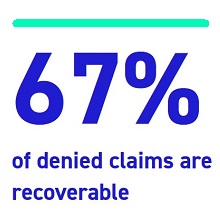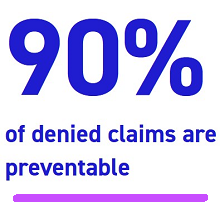Karla Hiravi, BSN | June 10, 2020
In the medical denials and appeals world, a clinical validation audit is done to ensure billed diagnoses and conditions are validated by the medical record. If a clinical validation denial is made, the auditor is claiming that the diagnosis or condition is not valid for clinical reasons. The auditor might change a diagnosis to something else, or might even completely remove the diagnosis with no replacement.
The vast majority of times, the denied diagnosis makes a difference in the DRG or the severity of illness (SOI) – usually a downgrade to a lesser SOI, or a DRG with a lesser relative weight than that of the billed DRG.
Let’s look at an example.
Ms. Lily O’Valley was a 79-year-old lady who presented to the Emergency Department with a fever and a productive cough. Crackles were heard on auscultation of the left lower lobe; the WBC was 12.4 with 11% stabs. The chest X-ray impression stated the test was technically difficult and did not demonstrate overt signs of pneumonia. Of note, the body of the report stated that an infiltrate in the left lower lobe could not be excluded. Ms. O’Valley was diagnosed with community-acquired pneumonia and treated appropriately. Her WBCs decreased, her left shift resolved, and her symptoms and lung sounds improved. Unfortunately, she also had a noninfected stage 3 pressure ulcer on her sacrum (present on admission) that required a wound nurse consultation, position change every 2 hours, and wound care twice a day, as was done at home. After nearly 5 days of hospital care, she was deemed ready for discharge.
The billed DRG for this patient was 193, Simple Pneumonia with MCC.
An auditor (unknown credentials) reviewed the medical record and denied the diagnosis of pneumonia, stating that because the chest x-ray did not show any evidence of pneumonia, bronchitis was the more appropriate diagnosis. Therefore, pneumonia was removed and changed to bronchitis. There was no disagreement about the stage 3 pressure ulcer. The DRG was changed to 202, Bronchitis and Asthma with CC/MCC.
Let’s see how the above scenario impacted the hospital.
In this case, we will assume the hospital was reimbursed $5000 for every unit of relative weight.
Billed DRG Relative Weight GMLOS ALOS Reimbursement
193, Simple Pneumonia 1.3335 4.2 5.2 $6,667.5
with MCC
Revised (Auditor’s) DRG 0.9480 3.0 3.7 $4,740
202, Bronchitis & Asthma
with CC/MCC
What are some of the ways such a denial, if not contested and overturned, impacts the hospital and attending physician?
- Hospital CMI is negatively impacted.
Think about this case and multiply it by xxxx similar cases… it adds up!
- Physician CMI is negatively impacted.
“Doctor, why did you keep this patient in the hospital for nearly 5 days when she could/should have been discharged in about 3 days?”
- Hospital and physician public “report cards” can be negatively impacted.
“Honey, I think we should switch to another hospital and doctor. I just saw the report card for our doctor and hospital online.”
- Reimbursement to the hospital is negatively impacted.
“We are sorry to have to tell you this, but your job has been eliminated.”
- The case is now potentially at risk for a level of care denial.
How many patients get admitted to inpatient status with bronchitis?
It is always best practice to zero in on the actual reasons for denial and decide the next steps. In the example given above, an effective appeal should focus on the clinical aspects that support the clinical validity of pneumonia.
I like to think we have a Golden Rule for appeal writing: Never assume the auditor’s statements are factual or complete. Scrutinize the medical record to see if the reasons for denial can be contested.
- What did the chest x-ray report state in its entirety? Don’t just read the impression – read the body of the report as well – and be sure to understand the radiologist’s terminology. There is a big difference between a negative chest x-ray reading as compared to a chest x-ray that was difficult to perform and an infiltrate could not be ruled out.
- What were the antibiotics that were chosen? Were they specific for community-acquired pneumonia?
- Resolving leukocytosis and left shift are good indicators that the treatment supported the diagnosis.
- A decrease in symptoms and physical findings helps to support that the treatment supported the diagnosis.
- Was an entire course of treatment completed or to be continued after discharge?
It is important to note that there is a difference between coding denials and clinical validation denials. In clinical validation denials, the coding is often flawless. Appealing a case such as the above, based solely on coding guidelines, Coding Clinics, and coding conventions, might not get overturned because the coding was not in question.
Each hospital must make decisions on how to appeal clinical validation appeals, and who the writers should be. Some hospitals use their coding professionals to appeal this type of case. Some use clinicians. A combination of clinicians and coding professionals are oftentimes utilized. Others tap into their clinical documentation specialists’ expertise. Sometimes a decision is made to outsource this work. Regardless of who does the clinical validation appeals, be sure that the reasons for the denial are addressed thoroughly, and on a clinical basis.
About the Author:
Karla Hiravi, BSN, RN | Clinical Audit and Appeal Services
Intersect Healthcare + AppealMasters
Karla is a Registered Nurse and holds a BSN from the University of Pittsburgh, Johnstown. Karla has more than thirty years of service in the healthcare industry, including extensive and varied clinical experience, research, clinical documentation improvement, management, development of a successful hospital based oncology research program, and development of a successful denial appeal program. Karla has personally authored hundreds of successful appeals and presented dozens of cases at the ALJ level.
Contact the author:




